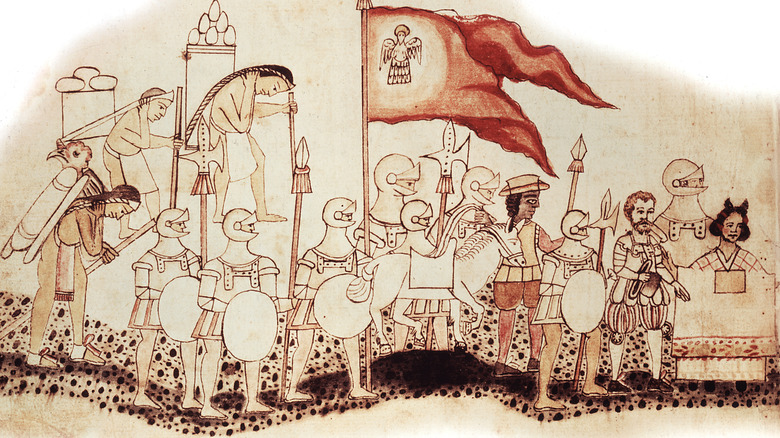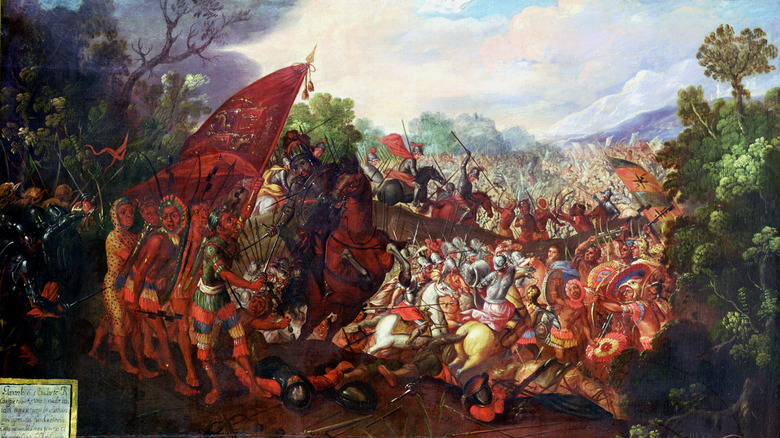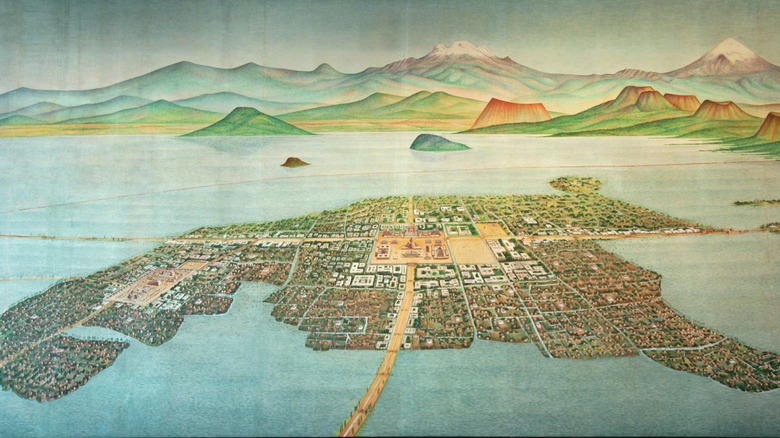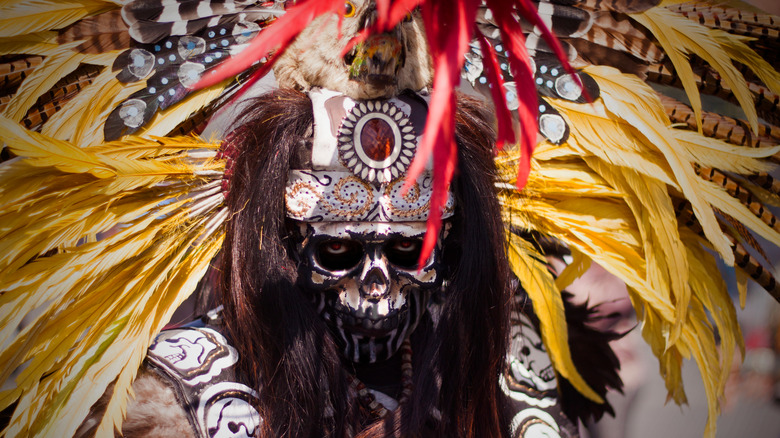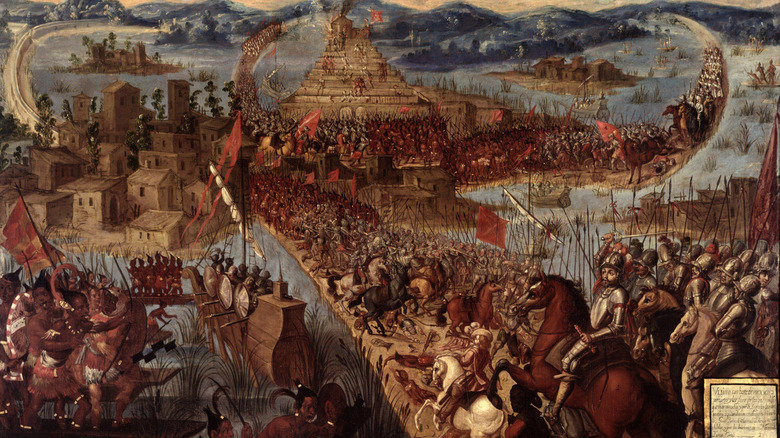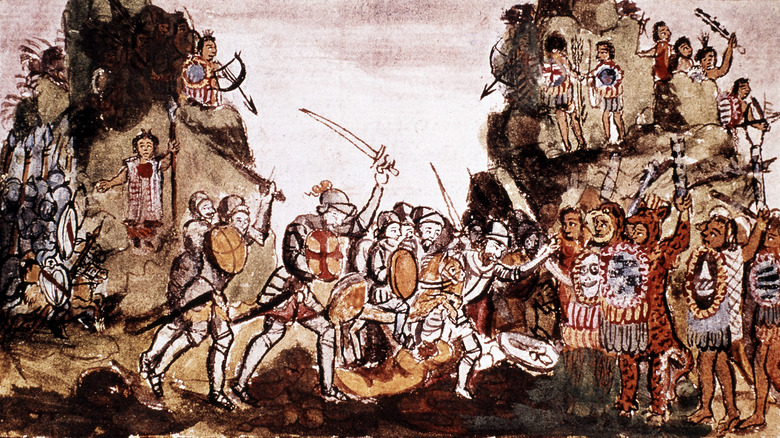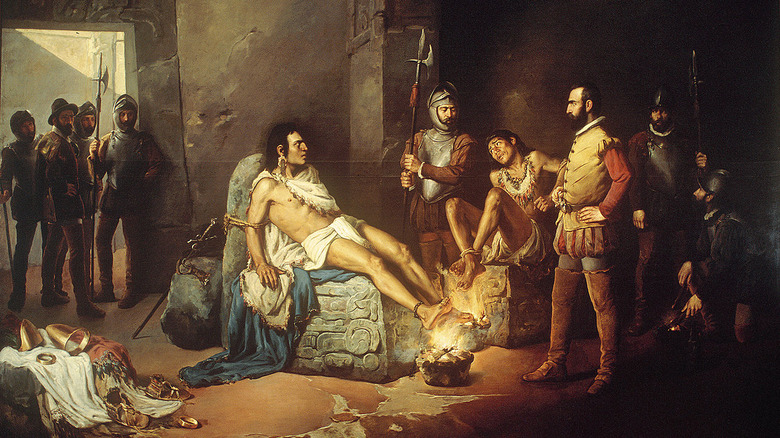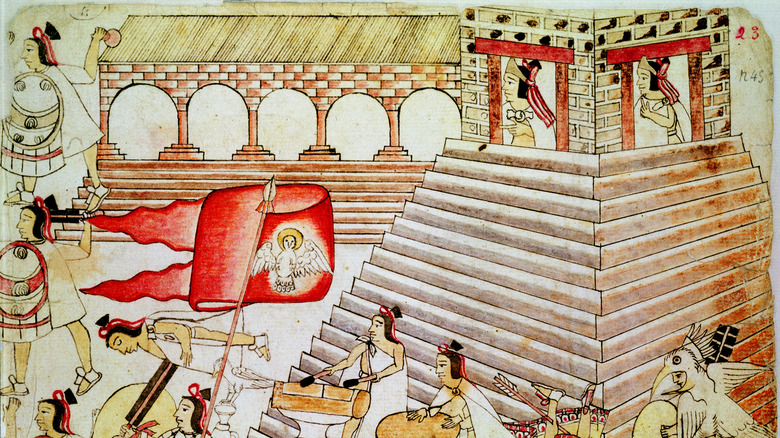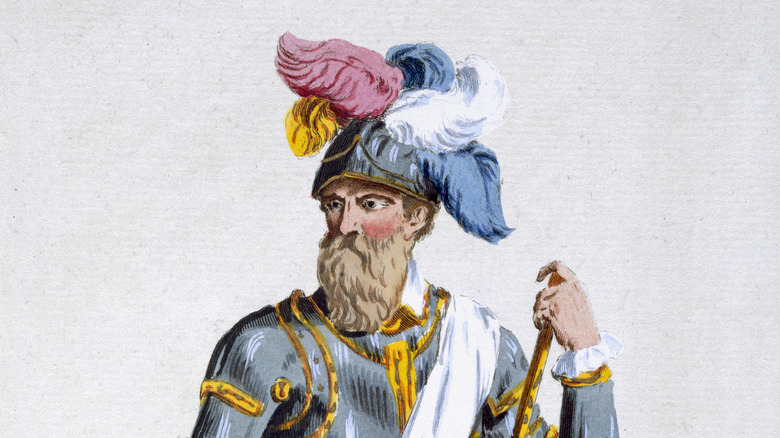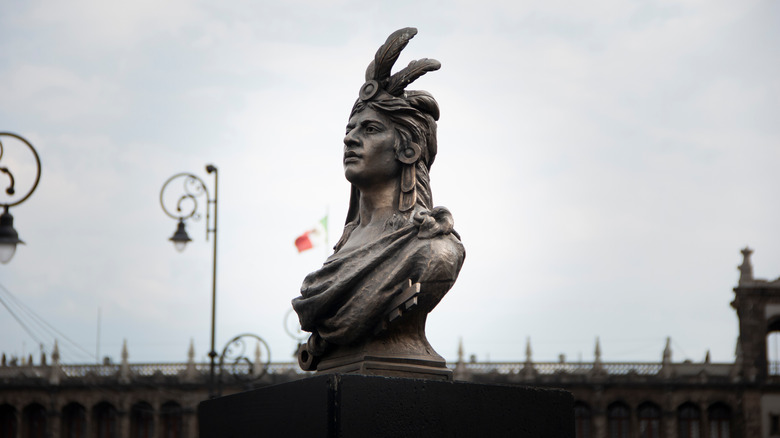A Look Back At Cuauhtemoc, The Last Aztec Emperor
Cuauhtémoc or Quauhtemoctzin, whose name means "descending eagle" in the Aztec language, was the last Aztec Emperor to rule from the capital city of Tenochtitlan. Although his reign was tragically short — he came to the throne in 1520 and was captured by the Spanish in 1521 — he was also a larger-than-life figure who won the respect of both friend and foe alike.
Cuauhtémoc came to power during a moment of crisis in Central America when the Spanish conquistadors led by Hernán Cortés were dismantling the Aztec Empire from within. Holding out during one last bloody siege, Cuauhtémoc saw his city burn, his people slaughtered, and his nation destroyed. However, his fighting spirit stayed strong till his last moments when he was executed for a conspiracy against the invaders.
Today, Cuauhtémoc's face can be found all over Mexico, where he is regarded by many as an indigenous hero. Despite his short reign, his doomed last stand against the Spanish still stirs hearts and minds.
Cortés arrives
Before Cuauhtémoc's very short reign began, the Aztec Empire was thrown into crisis by the arrival of the Spanish conquistadors. The problems that eventually dethroned Cuauhtémoc began under one of his predecessors — Montezuma II. Montezuma was on the throne when Hernán Cortés showed up via Cuba in 1518, looking for gold and glory.
Although Cortés had nefarious designs on the Aztec empire, he was treated with a great deal of reverence and respect when he first arrived — something that the Aztecs would come to regret later. Although Cortes did not have many men with him when he reached Mexican shores, he quickly secured the backing of the discontented local Tlaxcala people and he brought guns and horses with him — technological advantages the Aztecs did not have. According to some, Montezuma may also have believed that Cortés was a god, although this story is disputed. Whatever the case, the intimidated emperor let the conquistadors pass unmolested into the Aztec capital of Tenochtitlan and just two weeks later Montezuma found himself a prisoner in his own city.
Cortés forced Montezuma to swear allegiance to Spain but his abject betrayal did not go down well. After Cortés left the city to resolve a dispute, chaos broke out, and Montezuma was killed in the weeks that followed. According to one version of the story he was dispatched by an angry mob of Aztecs. Upon his return, Cortés was forced to flee Tenochtitlan during the "night of sadness." Meanwhile, the Aztecs looked to appoint a new leader — somebody with a healthy disdain for their Spanish visitors.
Cuauhtémoc steps up
After Montezuma II died, one of his brothers, a warrior named Cuitláhuac took the throne. Cuitláhuac was a capable leader, and he helped to throw the Spanish out of Tenochtitlan for a time. However, like so many other indigenous people in the Americas, he passed away from smallpox having ruled for less than three months.
Following his death, the last Aztec emperor, Cuauhtémoc, took the throne. According to "The Memoirs of the Conquistador Bernal Diaz del Castillo," Cuauhtémoc was still very young but he was also a close relative of Montezuma and had been married off to one of his daughters. The new emperor had briefly been imprisoned by the Spanish and his hostile attitude to the unwanted visitors was exactly what the Aztecs needed. Unlike the much weaker Montezuma, Cuauhtémoc immediately took aggressive steps to counteract the actions of the conquistadors.
Spain had a major advantage against the Aztecs when they arrived because many local indigenous people actually resented Aztec rule. Accordingly, Cuauhtémoc set about fortifying the towns and cities around Tenochtitlan, plying them with gifts to keep their loyalty. As a disincentive against supporting the Spanish, he also decreed that those who had already converted to Catholicism be brutally sacrificed. Unfortunately, some of Cuauhtémoc's activities may have had the opposite effect to the one intended. According to the Spanish account, the new Aztec garrisons terrorized local towns, devouring their food and harassing their women.
Holding the Spanish at bay
Hernán Cortés was determined to wrestle the Aztec capital from Cuauhtémoc but victory would not be easy. The once remarkable city of Tenochtitlan sat on an island on a lake, which made it formidably defensible; in order to get into the city the Spanish had to traverse a series of causeways that ran across the lake, each of which could be defended by lifting bridges at strategic points along their lengths.
Although the Spaniards built works to cross these gaps, the Aztecs repeatedly destroyed them at nightfall. During one particularly dramatic assault, Cuauhtémoc achieved a major victory when a group of Spanish soldiers became trapped on one of the causeways, which the Aztecs had deliberately made narrower. The helpless division was swarmed by an overwhelming number of fighters, who arrived in the shallows in their canoes. That same day, the other Spanish divisions were also routed, unable to make their way down the narrow paths to the city. The result was a humiliating defeat, during which Cortés was wounded in the leg, and almost captured.
To celebrate their victory, the men the Aztecs captured in the battle were sacrificed to the Aztec gods. The Spanish listened in the distance as these grisly ceremonies were carried out. One conquistador, who wrote an account of the battle explained: "As we were thus retreating, we continually heard the large drum beating from the summit of the chief temple of the city ... every time we heard its doleful sound, the Mexicans, as we subsequently learned, offered to their idols the bleeding hearts of our unfortunate countrymen" (via "The Memoirs of the Conquistador Bernal Diaz del Castillo").
A Surprise attack
Before the city of Tenochtitlan was finally taken, Hernán Cortes offered Cuauhtémoc peace terms, according to "The Memoirs of the Conquistador Bernal Diaz
del Castillo." The conquistadors by this stage had begun to cut off the city's water supply in an attempt to crack its inhabitants.
Bernal Diaz del Castillo records that Cuauhtémoc took this offer seriously at first, both because the Aztecs were hungry and because many Mexican towns had already turned their backs on them. If Cuauhtémoc had accepted the surrender at this early stage, he may have saved many lives, and the city of Tenochtitlan itself, whose beautiful streets would soon crumble into dust under heavy cannon fire. However, during a meeting of Cuauhtémoc's war council, some of his advisors talked him out of it, reassuring him that all the religious omens pointed to a home victory. The Aztecs also decided that they could source their water from the surrounding towns still loyal to them, so they had no need to fear this new Spanish strategy.
By way of a response to the peace request, three days after the delegation was sent, the Aztecs launched a surprise attack. Crashing into the Spanish camp quite unexpectedly, they caused disorder among the conquistadors for days, although they still did not manage to overwhelm them.
The Fall of Tenochtitlan
Although Cuauhtémoc put up a spirited defence, he could not hold the Spanish back forever. Spanish gunpowder and the gradual starvation of the Aztecs seriously weakened their chances of victory and the conquistadors continued to ask Cuauhtémoc to surrender. In his Third Letter to Charles V, Hernán Cortes himself wrote that he viewed the inhabitants with great pity as they started to die in droves, "an immense multitude of men, women and children were compelled to seek refuge with us, many of whom in their eagerness to reach us threw themselves into the water, and were drowned amongst the mass of dead bodies. It appeared that the number of persons who had perished, either from drinking salt water, from famine or pestilence, amounted altogether to more than fifty thousand souls."
The Spanish made multiple forays into the heart of the Tenochtitlan and pitched battles swept the streets as the two sides fought for control of each neighborhood. When the Aztecs pelted the Spanish from above, the Spanish responded by burning the city down. They used canons to flatten whole buildings and districts, and increasingly men and women surrendered in droves, recognizing they were fighting a losing battle.
Cortés began a desperate search for the commander-in-chief, hoping to face him directly and so end the war. But Cuauhtémoc had made a run for it, having set off in a canoe, to avoid the Spanish soldiers.
Cuauhtémoc's capture
After the Spanish succeeded in seizing most of the city of Tenochtitlan, many Aztecs piled everything they could carry into their canoes and sped across the surrounding lake to safety, according to "The Memoirs of the Conquistador Bernal Diaz del Castillo." Among them was the emperor Cuauhtémoc himself, cast adrift in an elaborately carved vessel. Unfortunately, the Spanish spotted his escape, and their ships were much too fast for his fleeing canoe. Before long Cuauhtémoc found himself eyeball-to-eyeball with the Spanish soldiers, who pointed their crossbows at him and called for his surrender. Giving up the ghost, Cuauhtémoc came along quietly, only asking mercy for the women and children who accompanied him.
When they finally came face-to-face, Hernán Cortés and the other Spanish commanders were surprisingly impressed by the young emperor. Bernal Diaz del Castillo noted that the young Aztec had a handsome and noble appearance and conducted himself with great dignity in the face of death. Greeting Cortés in tears, he offered to die right then and there, asking the Spanish commander to stab him in the heart.
Cortés refused to dispatch the emperor but he did accept his surrender. After 93 days, the siege was finally lifted on the August 13, 1521. Seeing that their Emperor had been brought before Cortés, many local men and women fled to the neighboring towns and villages but were robbed by passing Spaniards along the way.
The emperor is tortured
Hernán Cortés' attitude toward his royal prisoner quickly turned nasty after the emperor refused to cooperate with Spanish attempts to find more Aztec treasure. From the very beginning, the Spanish delusionally believed that the Aztecs were sitting on a mountain of precious gold. While they did find a fair amount of booty in wealthy Tenochtitlan, it was not enough to satisfy Spanish appetites.
Cuauhtémoc was questioned about the whereabouts of this hidden treasure, and when he gave them nothing, he was tortured. According to the version of this story from "The Memoirs of the Conquistador Bernal Diaz del Castillo," Cortés felt somewhat guilty about this but he gave in when his crown officers pushed him to do it. Dishonoring the man he supposedly so respected, Cortés allowed his men to apply boiling hot oil to the emperor's feet, and to the feet of his ally, the king of Tlacupa. Later, when Cortés got in trouble with some local Spanish bigwigs who thoroughly disliked the commander, the unwarranted torture of the Aztec emperor was listed among their complaints against him.
Cuauhtémoc eventually cracked and told the conquistadors that they had thrown the rest of King Montezuma's treasury gold into the lake surrounding Tenochtitlan. However, when searchers found nothing, he later insisted that he had made the whole story up to annoy them.
Cuauhtémoc finds new employment
Despite the fact that Hernán Cortés had by now tortured and humiliated the last Aztec emperor, he appears to have trusted him enough to keep him on as an employee or enslaving him (depending on which source you read). According to "The Memoirs of the Conquistador Bernal Diaz del Castillo," Cortés gave Cuauhtémoc an administrative role and ordered him to rebuild part of the devastated city of Tenochtitlan. This restoration project included the repair of the aqueduct that the Spanish had deliberately destroyed, as well as the burial of the many corpses still rotting in the streets. At the same time, in order to pacify the Aztecs, Cuauhtémoc was forcibly converted to Christianity and given the Christian name "Fernando."
Later, Cortés took his prisoner away on an expedition to Honduras, possibly as a soldier, although the sources aren't quite clear. This expedition was originally an excuse to explore more of Latin America, but it evolved into a mission to arrest a rogue official. To prevent a rebellion arising in his absence, Cortés took Cuauhtémoc and the King of Tlacupa along with him, as well as a number of indigenous troops.
The plot to kill Cortés
Whatever Hernán Cortés may have believed about the Aztec Emperor, it transpired that he had not won his obedience. While Cuauhtémoc was on a Honduran expedition with Cortés, he supposedly plotted to kill the Spaniard, along with all his soldiers.
According to the account given by Bernal Diaz del Castillo, Cuauhtémoc and the other indigenous chiefs who came on the expedition saw that the Spanish party was sick and tired, and believed that they could dispatch them with ease. Taking advantage of their weakened state, the group agreed to attack the Spaniards when they came to a difficult crossing point, such as a river or a marsh. Once the party was eliminated, the plan was to raise a rebellion against Spanish rule. Unfortunately for Cuauhtémoc, several indigenous soldiers ratted him out and the matter was investigated by the Spanish. When questioned, the emperor claimed that although the discussion had taken place, he had no real desire to rebel against his new masters.
One of Cortés' letters to Charles V, presents a slightly different version of the story. In Cortés' account, an indigenous man passed him a note which contained details regarding a plot to kill him. The plan allegedly involved killing every Spaniard in the province they were in, as well as throughout Aztec lands, and so "By these means, they would rule again as before, and they had already distributed the different provinces amongst themselves..."
Death of the Last Aztec
Having uncovered the Aztec plot to kill him, Hernán Cortés sentenced Cuauhtémoc and his countrymen to death. A group of monks traveling with the party attempted to console Cuauhtémoc in the face of death, and a man named Father Juan heard the last confessions of the now-Christian conspirators, in their native language.
Cuauhtémoc was hung, along with the other conspirators, after uttering the last words: "Oh Malinche! I have for a long time perceived, from your false words, that you had destined me for such a death because I did not lay violent hands on myself when you entered my city of Mexico! Why are you thus going to put me unjustly to death? God will one time ask this of you!" (via "The Memoirs of the Conquistador Bernal Diaz del Castillo").
Supposedly, Cortés was later plagued by guilt for the hanging, and Bernal Diaz del Castillo, the conquistador who wrote the account of the execution, mentions his own personal sadness about the emperor's passing. In the end, Cuauhtémoc's personality and great personal dignity had won over even his enemies. According to legend, after his execution, the emperor's bones were secretly spirited away by a group of Aztec warriors and interred at his rumored birthplace in Guerrero, Mexico.
The Emperor's Bones
Cuauhtémoc's contribution to Mexican history has not been forgotten. Many places in Mexico are now named after the last warrior emperor, and his face can be found on Mexican banknotes. An enormous statue of his noble visage was erected in Mexico City as early as 1887, not far from a different bronze statue of Christopher Columbus.
In 1949, an archaeologist claimed that the great emperor's bones had been rediscovered in an Aztec cemetery in the state of Guerrero Mexico, where Cuauhtémoc was supposed to have been born. Although the claim is dubious (it was officially debunked in 1976), the fanfare around the body represents an interesting cultural phenomenon — the reclamation of Mexico's pre-Spanish heritage. Unlike the treacherous Montezuma, Cuauhtémoc is easy to hold up as an underdog hero. More than ever, nationalists in Mexico are leaning into their ancient heritage, by celebrating indigenous heroes, ancient gods, and pre-columbian political figures.
Ixcateopan, the village where Cuauhtémoc's remains are supposed to have been found, has seen a remarkable increase in tourism in recent years, and an annual festival celebrating the last emperor has become a new tradition. Men and women gather here on the emperor's birthday, dressed in traditional costumes, to dance and celebrate Cuauhtémoc's short life.

